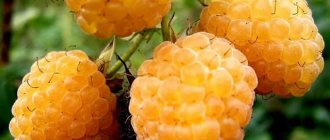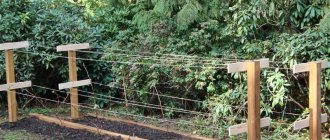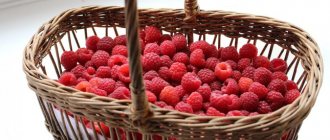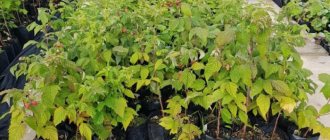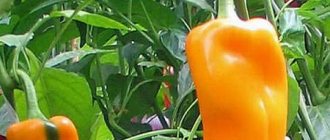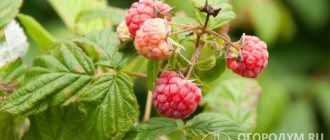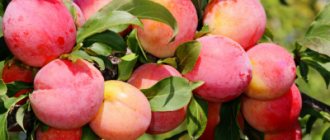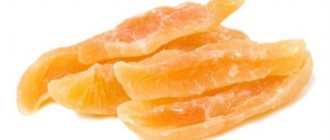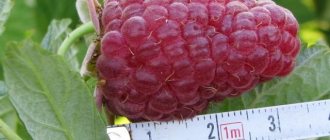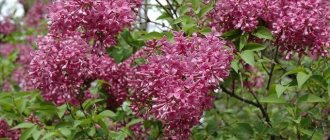We offer a selection of proven varieties of yellow raspberries that will delight you with a generous harvest of tasty and healthy berries.
We’re willing to bet that when you hear the word “raspberry,” your mind conjures up a quite appetizing picture of a ruby-red berry, which you pick from the bush and happily put in your mouth. What about yellow-fruited raspberries? The berries of these varieties are good not only for their unusual colors, but also for their excellent taste.
Yellow raspberries are sweeter than their red-fruited “sisters” and do not cause allergies. That is why it can be eaten without restrictions by pregnant and lactating women, small children and people with allergies. A miracle, not a berry!
The only disadvantage of yellow-fruited raspberries is its “delicacy”. It is stored and transported worse than red fruit. But this minor drawback doesn’t stop us from pampering ourselves with this delicious berry during the season, does it?
Yellow raspberries are suitable for allergy sufferers, small children and nursing mothers
If you decide to plant yellow raspberries on your site, we advise you to choose one of these 8 varieties. We guarantee you won't regret it!
Amber
The name of this variety is translated from English as “amber”, and it fully justifies it. Amber berries are characterized by a beautiful amber hue, sweet aroma and excellent dessert taste.
Raspberries of this mid-late variety cannot boast of large fruits, but they are practically not susceptible to disease and winter well, without requiring shelter.
| Fruiting | Bush height (m) | Fruit weight (g) | Pulp | Peculiarities |
| End of July – September | 2-2,5 | 3-4 | Sweet, dense | Resistant to diseases and pests |
Yaroslavna
Yaroslavna is a remontant variety of yellow raspberries with an average ripening period. Brought out by Ukrainian breeders, it is well suited for growing in its homeland, and also quickly adapts to the climatic conditions of Russia. The fruiting period is extended. The bushes are of medium height (up to 180 cm), slightly spreading, show weak branching, and provide a sufficient amount of root shoots for reproduction. The berries are large (about 6 g), round-conical, yellow-orange in color, sweet, tender. Productivity is high (up to 4 kg per bush). It can be grown as a tutaymer, with two harvests - summer and autumn. Prefers slightly acidic soil (pH 5.7-6.5) with good aeration. Disadvantages include rotting berries if harvested untimely, as well as average transportability of the crop.
As part of the current article, we tried to provide objective information about all varieties of yellow raspberries that are actively cultivated in Russia and the CIS countries at present. We are very glad if you liked the material! We are waiting for your comments. We would be grateful if you leave a link to the article in your social article so that everyone can choose varieties based on real characteristics, and not on the financial interests of a particular nursery.
Fugitive
The Beglyanka raspberry variety cannot be called super-yielding (on average, you can get about 2 kg of berries from a bush), but it is unlikely to cause you much trouble. She is not afraid of frost, pests and fungal diseases. But it is worth paying attention that plants of this variety are susceptible to infection by spider mites and mycoplasma overgrowth.
The fruits have an excellent taste with a slight sourness. And what a scent comes from the bush! This variety definitely deserves your attention.
| Fruiting | Bush height (m) | Fruit weight (g) | Pulp | Peculiarities |
| July-September | 1,5-2 | 3 | Sweet and sour | High winter hardiness |
Reviews from gardeners
★★★★★
Anastasia Pavlovna, 65 years old, summer resident, Moscow. One day I saw a fresh raspberry bush at my neighbor’s dacha, all sprinkled with bright yellow berries like amber, and I wanted to have the same beauty for myself.
And, remembering my diabetes, and the opportunity to eat yellow raspberries almost without regard to the disease, it was decided to grow one in my garden. ★★★★★
Valery, 38 years old, gardener, Chelyabinsk. I have been growing yellow raspberries of the Yellow Giant variety for many years.
The conditions of Siberia do not interfere with obtaining 2-3 buckets of berries annually from a relatively small plot. I don’t make any special efforts in growing it, everything is the same as for the rest of the garden: manure, loosening, weeding. The disadvantages include strong growth; if not trimmed in time, it will fill the entire garden. We collect berries all summer, they are juicy, sweet, and quite large. What we don’t eat, we freeze for the winter, and we save ourselves during an epidemic of colds.
★★★★★
Olga, 29 years old, summer resident, Donetsk. By chance, as they say, almost for change, I purchased a yellow raspberry seedling of the Golden Autumn variety.
And imagine my surprise when, that same summer, we received almost 2 kg of berries, seemingly from a small first-year bush. But personally, in terms of taste, I prefer red raspberries, which are not as sickly sweet as yellow ones. But the children are absolutely delighted with both the taste and the color, so they decided to get a couple more bushes. Hide
Add your review
Every year, yellow raspberries, thanks to their qualities, win the love of gardeners and gardeners. And for good reason, most tasters award yellow raspberries up to 4.7 points for berry flavor.
0
0
Copy link
Yellow dessert
This variety of yellow-fruited raspberry was bred in the Primorsky Territory more than half a century ago, but is still popular among gardeners. Yellow Dessert bushes do not necessarily require bending the branches to the ground and covering them for the winter, but thanks to this procedure their productivity can be significantly increased. With proper care, you can collect more than 2 kg of juicy berries from one bush.
| Fruiting | Bush height (m) | Fruit weight (g) | Pulp | Peculiarities |
| July-September | 1,5 | 2 | Sweet, juicy | When overripe, the berries fall off the bush |
The benefits of yellow raspberries for the human body
Most red berries can cause allergic reactions due to the content of anthocyanins - substances responsible for the purple, blue and red color of plant parts. Therefore, young children, pregnant women and people with allergies are advised to use them with extreme caution, and perhaps even switch their attention to berries of other colors. Such as, for example, yellow raspberries.
This berry is not very common among gardeners, but having a number of significant advantages, it can take pride of place in the gardens of summer residents. Features of the biochemical composition of yellow raspberries are as follows:
- low amount of organic acids;
- high content of sugars, folic acid or vitamin B9;
- the presence of minerals such as iron and copper.
Yellow raspberries are also widely popular in traditional methods of treatment. Apply as:
- diaphoretic, for fevers, ODS;
- a remedy that stabilizes body temperature during colds;
- decoctions of leaves, relieve cough, in complex therapy;
- berries regulate digestion;
- natural antidepressant and sedative.
Yellow giant
This variety of raspberries is a giant in every sense. The height of the bush can reach 2.5 m, and the weight of one fruit is 6 g. This large-fruited raspberry is juicy, aromatic, sweet with a pleasant sourness.
It is worth noting the weak side of the Yellow Giant: the bushes of this variety do not have good winter hardiness. In autumn, shoots must be bent to the ground and covered. The yellow giant shows signs of remontancy and can produce two harvests per season.
| Fruiting | Bush height (m) | Fruit weight (g) | Pulp | Peculiarities |
| July-September | 2-2,5 | 4-6 | Sweet and sour, juicy | Requires shelter for the winter |
Raspberry variety Morning dew (Poranna Rosa) - what do you need to know?
One of the most promising for small-scale farms due to the low demand for yellow raspberries in general. More of an industrial variety than a dessert one, gardeners will also like it due to its low whimsicality and yield. Here is a description of the Morning Dew raspberry.
- Bred at the Institute of Horticulture and Floriculture in Bzezdna, also known as Poranna Rosa.
- The yellow-fruited variety is remontant and transportable. The shoots are 1.5 m long, strongly spiny, but the spikes are short, straight, and hard.
- Belongs to large-fruited, the berry is round - spherical in shape, golden-yellow, tasty.
- It bears fruit on annual shoots from mid-August until the end of the growing season; sometimes repeated fruiting is possible at the end of June.
- The fruiting zone is half the length of the shoot. Commercial grade. The taste is sweet and sour, more sour in hot weather, which is why it is not recommended for the southern arid regions. The best commercial variety of yellow-fruited remontants.
What about the disadvantages?
In comparison with red-fruited and black-fruited varieties, it contains less organic, incl. fruit acids - its taste is more delicate. There are higher levels of sugar in fruits. Due to the low amount of anthocyanins and coloring substances, it is a godsend for allergy sufferers. Anthocyanins cause intolerance to fruits in people suffering from allergic diseases. Useful for pregnant women and children due to the high amount of folic acid, vitamins B9, B6, C.
- With a lack of moisture it is sour, and even with sufficient irrigation the same Diamond is sweeter, the Yellow Giant.
- Susceptible to pests and diseases - rumors are too exaggerated, suffers on a par with varieties, susceptibility by 3-4 points.
- It tolerates heat of +30-35 C quite well, there are no attacks, the berries are rarely baked, only under direct rays at peak high temperatures. However, at temperatures below 20-25 C the taste is better, the berries are juicier and sweeter.
- It produces a lot of growth with proper agricultural technology - sufficient watering, loose soil, seedlings take root well.
Caring for Morning Dew raspberries is simple.
- Fruiting twice a day is not the best choice; one in the fall is better. Therefore, pruning at the root after fruiting is recommended.
- In most cases, no support is required.
- At temperatures below 35 C, cover for the winter.
Golden autumn
Raspberries of the remontant variety Golden Autumn can withstand frosts down to –30°C. In addition, it attracts gardeners with large, tasty fruits, fairly high yields (about 2.5 kg per bush) and good transportability.
It is worth considering that Golden Autumn seedlings must be planted in a well-lit area, since raspberries of this variety are photophilous and do not do well in the shade.
| Fruiting | Bush height (m) | Fruit weight (g) | Pulp | Peculiarities |
| From August until frost | 2-2,5 | 5-7 | Dense, sweet | High frost resistance, good transportability of berries |
Known varieties
What makes the yellow raspberry variety famous is not so much the high yield or earlier ripening of the fruits, but the availability of planting material and tasty berries. Children simply adore them. They may be called differently, but the result exceeds expectations. We offer an overview with photos and descriptions of the most popular varieties.
Important! Remontant varieties - harvested twice a year, bearing fruit on the branches of the current year.
Semi-remontant species - they bear fruit only partially on the branches of the current year
-
the first harvest ripens on the upper part of the shoot this year, the lower part of the branch bears fruit the next year. Regular varieties - the fruits ripen on last year's shoots.
Amber
Amber, which in English means amber. A remontant mid-late variety with high yield - almost 3 kg per bush. Winterizes well and does not require insulation. It has excellent immunity to diseases and pests. Bush about 250 cm high, strong, upright. Harvesting is from July to September. Amber colored berries. Fragrant, with a wonderful sweet taste and special aroma. The weight of one berry is about 4 g, with a dense pulp structure. Suitable for transportation and freezing.
Morning dew or Porana dew
The variety is remontant, with high yield. Tolerates winter well. Resistant to fungal and viral diseases. The bush is tall, about 180 cm, with short fruiting branches. Has a large number of thorns. This variety begins to bear fruit at the end of August and ends before the onset of the first frost.
A special feature of care is regular watering and loosening of the soil. The berry is large, with a sweet and sour taste, weighing about 8 grams. The pulp is dense, transparent light orange in color. The fruits tolerate transportation well and can be frozen.
Fugitive
This is a remontant, medium-yielding early variety. Resistant to temperature changes. Has high resistance to diseases. Bushes of medium height, with vertically growing branches. One bush produces up to 2 kg of raspberries.
For high-quality fruiting, the Beglyanka variety needs light, so planting it in the garden under trees is not recommended. The fruits have a golden hue. The taste is sweet and sour, with soft juicy pulp. Not suitable for transportation or freezing.
Apricot
Productive, remontant raspberry variety Apricot . Unpretentious in cultivation and resistant to frost. Is immune to diseases and pests. The average yield is about 3 kg per bush. The bushes are medium spreading and low. A well-lit place is required for planting. Berries with a mild aroma, sweet and sour taste, with delicate pulp , weighing about 3 g each.
They resemble an apricot in shape and taste. Apricot raspberries are recommended to be consumed fresh or canned. It is absolutely not suitable for transportation or freezing.
Yellow dessert
An early variety of yellow-fruited berry. It does not tolerate frosts and diseases well. The average yield is 2 kg of berries per bush . Requires insulation in winter. The bush is of medium height, about 150 cm. The branches are not very thorny, which makes it easier to pick berries. The berries weigh about 2 g, are pale yellowish in color, with a bright, pronounced aroma , very sweet in taste. Subject to transportation.
Yellow giant
Yellow Giant is a variety with signs of remontance and early fruiting. It has excellent yield - 6 kg per bush and immunity to common diseases and pests. Does not tolerate winter well; insulation is necessary.
The bushes are slightly spreading, up to 2 meters high. Due to the rapid ripening, the berries are prone to shedding. For planting, you should choose places on a hill where the sun's rays penetrate well. It is recommended to tie up the bushes. For better pollination, you can plant Alt Gold or Morning Dew raspberries nearby.
Did you know? Recent research by scientists has shown that eating raspberries “kills” up to 90% of tumor cells in the body.
The fruits are large, yellow, elongated. The weight of the berry is 8 g. The pulp is juicy, soft, with a sweet taste and delicate aroma. They do not tolerate long-distance transportation well.
Yellow penguin
Yellow penguin is one of the new remontant varieties of early ripening. Fruiting lasts all summer. With good immunity to diseases, but poor tolerance to frost. Before the winter period, it is necessary to cut off the shoots at the root. Productivity is about 6 kg per bush. Tree-like bushes, standard, up to 150 cm high.
It can be planted in soil of any structure with neutral acidity. The fruits are large, average weight - 7 g. Rich yellow color with a pinkish tint. The taste is sweet, with a slight sourness. They adhere well to the branches and do not fall off. Can be frozen and transported.
Golden autumn
Remontant high-yielding late variety Golden Autumn. Resistant to frost (up to -30°C) and easy to care for. Productivity - 3-4 kg per bush. The bushes grow up to one and a half meters. The density of the branches and spreading are average. The berries are large, weighing 4–6 g, yellow with a golden tint. The taste is juicy and sweet, with a light raspberry aroma. Can be transported and frozen.
Golden domes
Variety Golden Domes of remontant type, mid-early ripening period, with a bountiful harvest - from 2 kg per bush. Withstands temperatures down to -22°C. In unstable winters and sudden changes in temperature, it is recommended to cover the bushes. It rarely gets sick; for pests it is necessary to spray the bushes with fungicides in early spring, before the growing season begins.
The bushes are spreading, up to 150 cm high, so it is recommended to tie them up. The berries are sweet with a pleasant sour note, very juicy and tender, the flesh is dense. The average weight of the fruit is 6 g. The fruits are stored in the refrigerator for a long time and tolerate transportation well.
Did you know? Determining soil acidity is easy. You need to brew a few currant leaves with boiling water and cool. Pour the soil selected for planting raspberries into the water. If the water turns red - the soil has a high level of acidity, green - medium acidity, blue - neutral acidity.
Orange miracle
The plant belongs to a remontant variety, mid-early, high-yielding, up to 3 kg per bush. Resistant to diseases, but does not tolerate frost and heat. The bushes are spreading, tall, and thorny, which makes harvesting difficult.
The berries are velvety, yellow or bright orange. Fruit weight is about 5 g. The taste is sweet, with a barely noticeable sour note. The pulp is dense. Raspberry Orange Miracle is perfect for freezing and can withstand long-term transportation.
Yellow miracle
A remontant, mid-late variety with good yield - from 3 kg of berries per bush. Resistant to frost and diseases. The bushes are quite powerful and require garters and support. The berry is large, up to 8 g . Golden-yellow in color, with a light dessert taste and delicate aroma. The variety is universal, suitable for freezing and transportation.
Yellow sweet tooth
A mid-early common variety with excellent yield - up to 8 kg per bush. Resistant to pests and diseases. Winterizes well (provided it is insulated). The bushes are of medium height, about 150 cm.
The bushes do not need a garter or support. The berry is yellow-white or apricot in color , medium size. The pulp is very soft, aromatic and very sweet. When ripe it does not crumble. Raspberries of this variety are completely unsuitable for transportation or freezing.
Yaroslavna (Brusvyana)
Raspberry Brusvyana is a representative of the remontant variety. Medium ripening period. The yield is good, about four kilograms of berries per bush. Tree-like bushes, up to 170 cm tall. There are practically no thorns. No need to tie. The berries are a rich yellow color. Very large, weight - about 15 g, taste - sweet with well-defined sourness. Transports well.
Fallgold
Folgold is a late remontant variety. Productivity reaches 7 kg per bush . Resistant to diseases and pests. Bush: tall, powerful, about 2.50 m in height. Requires fixation to the trellis. The fruits are large, weighing from 4 to 7 g, very aromatic, with a sweet dessert taste and pineapple aftertaste, which can be frozen and transported.
Zyugan
The Zyugana variety is a remontant variety, high-yielding - up to 9 kg per bush. The bush is upright, powerful, branches without thorns. It is not necessary to tie up the plant. The berries are large - up to 12 g. Sweet, juicy, very aromatic.
Judging by reviews from gardeners, fruits can be stored for up to 7 days in the refrigerator. They tolerate transportation well and do not lose their appearance when frozen.
Anna
This is one of the new, improved remontant varieties of yellow-fruited raspberries . Very early, fruiting begins in early June. It has increased resistance to common diseases and low temperatures. With a bush yield of 4 kg of fruit. The bushes reach 180 cm in height.
There are no thorns on the stems. Requires garters to trellises or stakes. The berries are large, weighing about 10 g, light yellow in color , and have banana notes in the taste. Pulp with a dense structure. Ripe berries do not fall off the branches. Transported well.
Zlata Yesenna
Remontant, mid-late variety, with a high yield - from 5 kg. Frost-resistant, has good immunity to diseases. Medium-sized bush, up to 160 cm. The spreading of the branches is moderate, but a garter is needed. There are few thorns, they are soft, and are mainly located on the lower branches of the bush. The berries are large - 5–7 g, orange-pinkish in color. Very sweet, without acid, with a delicate raspberry flavor, which can be transported and frozen.
Amber
Mid-late remontant variety. Resistant to temperature fluctuations, diseases and pests. The average yield is about 4 kg per bush. The plant is medium-sized, the spreading of the branches is weak, they are powerful and do not require garter or support.
The berry is a rich orange color, weighing up to 7 g, with soft pulp, sweet and sour taste, the aroma is weakly expressed. Not intended for transportation or freezing.
Chelyabinsk yellow
The variety is ordinary, medium-early ripening. Large-fruited, high-yielding, from 5 kg per bush. Frost-resistant, with good immunity to diseases. The bushes are powerful, semi-spreading, up to 220 cm in height. Requires garters and support.
The berries are pale yellow in color with a honey aroma and sweet taste. The pulp is juicy. The average weight of the fruit is 5 g. Not recommended for transportation and freezing.
Pineapple Vigorova
The variety is characterized by a mid-early period of fruit ripening, with high productivity - from 3 kg per season per bush. It withstands frost well and is resistant to diseases. The bushes grow up to 200 cm in height. No branch tying is required. The berries are large, up to 5 g, very sweet with pineapple flavor and tender pulp, but cannot be transported.
Yellow Spirina
A mid-late ripening variety with a yield of about 3 kg of berries per bush. Not frost-resistant, requires insulation in winter. Great tendency to diseases. The bush is of medium height and not very spreading. The berries are sweet, with a sour note, similar in taste to regular raspberries. The fruit size is medium, about 4 g. Fully ripe berries are golden, almost white. They are not subject to long-term storage and are not suitable for transportation.
Golden September
Remontant mid-early variety. Resistant to diseases and temperature changes. The average yield is about 2.5 kg per bush. Bushes with medium spreading branches, up to 150 cm in height. No garter required. The berries are large, about 8 g. Orange, with a golden tint, color. The taste is sweet, with a slight sourness. The pulp is dense. Berries can be transported.
Yolk
Medium ripening raspberries, regular variety. Tolerates frost and drought well. It has high immunity to diseases and known pests. The average yield is 3 kg of fruit per plant. Bushes with powerful branches, moderate spreading, height - up to 2.5 m. The berries are very large, the size of a matchbox. With tender flesh and sweet taste. Transportable.
Valentina
Early, common variety. Fruiting begins at the beginning of summer. Productivity is high, up to 5 kg per bush. It tolerates winter well, but is sensitive to pests. It has strong immunity to diseases. The plant is more than 2.5 m in height, the branches are massive, with a small number of spines. The berries are large, weighing 7 g, with hard pulp. The taste is very sweet and juicy, without acid. Transportability and storage are mediocre.
Honey
Mid-early, regular variety. It is noted for its high fruitfulness, up to 7 kg per bush , and excellent immunity to diseases and insects. It does not tolerate frosts well. In winter, plants need to be insulated. The branches grow up to 150 cm, the stems are thornless.
The berries are yellow in color, with an average weight of 4 g, with a good aroma and a sweet, dessert taste. They stay on the branches for a long time after ripening. Fruits cannot be transported.
Golden Queen
Golden Queen is a common variety with a medium ripening period . Noted for good yield, up to 6 kg per bush. Withstands frosts down to -30°C. Resistant to diseases and pests. The bushes are tall, about 250 cm. The thorniness of the branches is insignificant. The berries are large, weighing from 4 to 7 g, lemon yellow in color . Sweet, without sour aftertaste. Not suitable for transportation.
Golden domes
Raspberries of the Golden Domes variety are simple and unpretentious in care. It winters well, practically does not get sick and produces a good berry harvest - more than 2 kg per bush.
The fruits of this variety are fragrant, juicy with a slight sourness.
| Fruiting | Bush height (m) | Fruit weight (g) | Pulp | Peculiarities |
| From August until frost | 1,3-1,5 | 6 | Sweet and sour, juicy | Resistant to diseases and pests |
Anna
Anna is a remontant yellow raspberry variety bred in the USA. The bushes are of medium height (1.2-1.8 m), upright, compact, bend under the weight of the crop, and require the obligatory arrangement of trellises. The berries are large (5-7 g), light yellow in color, blunt-conical in shape. The drupes are tightly adhered to each other, the berries can be transported over long distances, do not wrinkle, do not leak, and do not spoil. The taste characteristics are excellent. The berries are sweet, aromatic, with a rich dessert aftertaste. Suitable for fresh consumption, all types of processing, freezing. The shoots are covered with thorns, but the thorns are sparse and small. Features include light green foliage of young shoots, fruiting only on the upper quarter of the branch, and susceptibility to verticillium wilt. The variety is new, but is already being sold in Russian nurseries and has good reviews from gardeners, primarily for its delicious sweet fruits.
Detailed description of the Anna variety
Orange miracle
The Orange Miracle variety got its name for its large fruits of rich golden color. They have a delicate aroma and sweet juicy pulp. The variety is remontant, so every year (in late autumn or early spring) the entire above-ground part must be cut out almost close to the ground.
Raspberries of this variety are planted in well-lit, windproof areas. It is not necessary to cover the bushes for the winter.
| Fruiting | Bush height (m) | Fruit weight (g) | Pulp | Peculiarities |
| From August until frost | 2-2,5 | 6-8 | Sweet, juicy | Doesn't like drafts |
Features of cultivation
Red and yellow raspberry varieties have almost identical agronomic techniques for planting and care.
Place
The landing site is chosen very carefully. The area should be open and well-lit, protected from wind and drafts, and without the formation of stagnant water. In order for the seedlings to receive the maximum amount of light, the rows should be placed in the direction from north to south. This method is especially relevant for regions with short summers. If there is a choice, then the most optimal place would be a slope of 8 degrees or a plain. You should not plant the plant in the place of the previous raspberry tree: the soil should rest for at least 5 years.
Autumn planting of raspberries
The soil
The ideal option for this plant would be light loamy or sandy loam soil. If the ground is too sandy, the plantings will require painstaking care.
Note! On acidic and heavy soil it is better not to plant raspberries at all.
Landing dates
Red and yellow raspberries are planted at the same time, that is, in the fall (late September-early October). In southern latitudes, the timing may shift up to several weeks, and spring planting is also possible.
Yellow sweet tooth
The main advantages of the Slastena yellow raspberry variety are excellent taste and high yield. In a good year, you can collect more than 3 kg of berries from a bush. What’s nice is that the fruits don’t fall off for a long time after ripening.
The variety is resistant to pests and diseases, but needs shelter for the winter.
| Fruiting | Bush height (m) | Fruit weight (g) | Pulp | Peculiarities |
| End of July – September | 1,3-1,5 | 3-6 | Sweet, juicy | Overripe berries do not fall off |
Whichever of these varieties you plant on your plot, we are sure that the delicious and healthy berries of yellow-fruited raspberries will not leave you indifferent!
Subtleties of care
Care for yellow raspberries must be of high quality. It is necessary to provide fertilizer, watering, tying and pruning. Only under such conditions will you get a good harvest.
Fertilizer
The time for applying fertilizer depends on how the crop was planted. The trench method is the most popular and implies compliance with the following dimensions: trench width 0.5-0.6 m, and row spacing 1.2-1.6 m.
The density is maintained based on the variety, but not less than 0.4 m, and the seedlings are not deepened. This method of planting delays the application of fertilizing.
If another method is used, then it is worth adding nitrogen, especially in the first couple of years after planting, because it is during this growth period that the plant especially needs nitrogen fertilizers. It is recommended to apply in early spring, but some agronomists divide it into two parts and apply one in the fall.
Most often, urea diluted with water is used. Other elements (phosphorus, potassium, boron, iron, manganese) are added if necessary. You can use manure and ash on your garden plot.
Watering
Yellow raspberries need to be watered abundantly, this promotes the development of powerful rhizomes and the penetration of roots into deeper layers of the soil. Like any other raspberry, without proper rooting, yellow raspberries will grow at high speed and cause a lot of trouble.
In the southern regions of the country, it is recommended to water yellow raspberries at least 6 times during the growing season. In mid-latitudes, 2-4 times are enough. Watering is usually done in furrows or by sprinkling.
Garter
Varieties of yellow raspberries that have a lush bush need a garter, otherwise the plant will scatter in different directions. In the first month of spring, you need to dig in the pillars and stretch the trellis over them. It is advisable to tie the bush in three places: at a level of 1.2 m from the ground and a couple of branches below.
Trimming
Although, through the efforts of breeders, a large number of rather unpretentious varieties of yellow raspberries have been developed, pruning is still a determining factor in increasing yields.
Remontant varieties are pruned almost completely in the fall before frost, and during fruiting, only shoots from which the harvest has already been harvested are removed. This care should not be ignored, since thickening of remontant raspberries leads to a significant reduction in yield.
Non-remontant varieties are pruned twice a year to increase branching.
Shelter for the winter
Yellow raspberry varieties were bred in the southern regions or in the central part of the country, so in these regions there is no need to cover the bushes. High frost resistance allows you to tolerate winter well.
In the northern regions of Siberia, given the more severe winter conditions, it is still worth taking care of covering with dry grass or earth. To do this, the bushes are bent and tied so that their height does not exceed 0.4 m.
